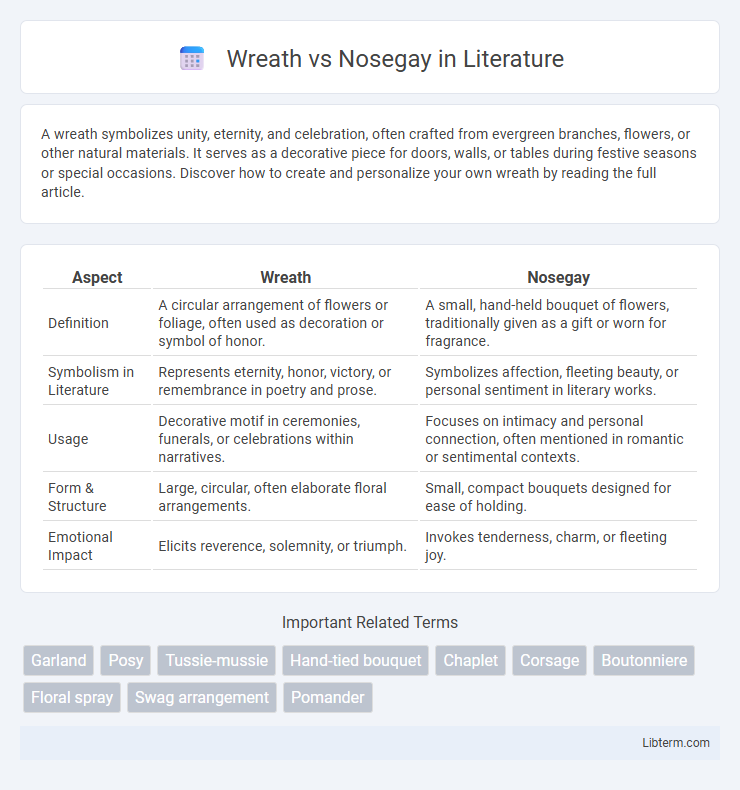A wreath symbolizes unity, eternity, and celebration, often crafted from evergreen branches, flowers, or other natural materials. It serves as a decorative piece for doors, walls, or tables during festive seasons or special occasions. Discover how to create and personalize your own wreath by reading the full article.
Table of Comparison
| Aspect | Wreath | Nosegay |
|---|---|---|
| Definition | A circular arrangement of flowers or foliage, often used as decoration or symbol of honor. | A small, hand-held bouquet of flowers, traditionally given as a gift or worn for fragrance. |
| Symbolism in Literature | Represents eternity, honor, victory, or remembrance in poetry and prose. | Symbolizes affection, fleeting beauty, or personal sentiment in literary works. |
| Usage | Decorative motif in ceremonies, funerals, or celebrations within narratives. | Focuses on intimacy and personal connection, often mentioned in romantic or sentimental contexts. |
| Form & Structure | Large, circular, often elaborate floral arrangements. | Small, compact bouquets designed for ease of holding. |
| Emotional Impact | Elicits reverence, solemnity, or triumph. | Invokes tenderness, charm, or fleeting joy. |
Introduction to Wreaths and Nosegays
Wreaths and nosegays both serve as decorative floral arrangements but differ in shape and usage. Wreaths are circular arrangements traditionally used for door decorations and symbolize eternity and unity. Nosegays, also known as tussie-mussies, are small, handheld bouquets designed to be fragrant and portable, often worn or carried during special occasions.
Historical Origins of Wreaths and Nosegays
Wreaths trace back to ancient Greece and Rome, where they symbolized victory, honor, and status, often crafted from laurel or olive branches for celebrations and ceremonies. Nosegays emerged in the 15th century as small, handheld bouquets designed to mask unpleasant odors and showcase fragrant herbs and flowers during the plague. Both floral arrangements evolved distinct cultural and functional roles, with wreaths serving as ornamental circles for various events and nosegays as portable sources of pleasant scents.
Design and Structure Comparison
Wreaths feature a circular design symbolizing eternity, crafted from interconnected foliage and flowers with a sturdy base that supports layered textures and uniform shapes. Nosegays are compact, handheld bouquets arranged with a central focal flower surrounded by smaller blooms, emphasizing a structured yet delicate form ideal for individual presentation. The design of wreaths facilitates display on doors or walls, while nosegays prioritize portability and intimate gifting through their tight, rounded arrangement.
Popular Materials Used
Wreaths commonly incorporate evergreen branches, pinecones, holly berries, and ribbon to create a durable, full-bodied decoration that symbolizes eternal life and festivity. Nosegays are traditionally crafted with a compact selection of fragrant flowers such as roses, lavender, and carnations, often accented with greenery and wrapped in decorative paper or lace. Both use natural elements but wreaths emphasize volume and longevity, while nosegays focus on fragrance and delicate presentation.
Symbolism and Meaning
A wreath symbolizes eternity, unity, and remembrance due to its circular shape with no beginning or end, often used in funerals and celebrations to honor lives and achievements. A nosegay, also called a tussie-mussie, represents personal sentiment and affection, traditionally given as a small bouquet conveying specific messages through the language of flowers. While wreaths emphasize collective memory and continuity, nosegays focus on intimate communication and individual emotions.
Occasions and Usage
Wreaths are circular arrangements commonly used for memorials, funerals, and festive decorations during holidays like Christmas, symbolizing eternity and remembrance. Nosegays, smaller and handheld bouquets, are traditionally given as gifts for weddings, proms, or as a token of appreciation, offering portability and personal sentiment. Each serves distinct purposes, with wreaths adorning spaces and nosegays enhancing personal accessories or intimate gestures.
Cultural Significance
Wreaths symbolize eternal life and unity in many cultures, often displayed during holidays and memorials to honor heritage and remembrance. Nosegays, historically used in Victorian England, reflect personal expression and were believed to ward off disease through their fragrant herbs and flowers. Both floral arrangements embody cultural rituals, with wreaths commonly adorning communal spaces and nosegays serving as intimate tokens or protective charms.
DIY: Creating Your Own Wreath or Nosegay
Crafting your own wreath involves selecting a circular base, such as wire or foam, and attaching foliage, flowers, and decorative elements to create a full, balanced design ideal for door or wall decor. Making a nosegay requires assembling a small, hand-tied bouquet of fresh or dried flowers, focusing on harmonious color and size arrangement for a compact, handheld floral display. Both DIY projects benefit from using seasonal blooms and incorporating ribbons or herbs to enhance fragrance, personal style, and visual appeal.
Maintenance and Preservation Tips
Wreaths require regular misting and should be kept away from direct sunlight and heat sources to maintain freshness, while nosegays benefit from daily water changes and trimming of stems to extend their life. Both floral arrangements last longer when stored in cool, humid environments to prevent wilting and preserve vibrancy. Using anti-desiccant sprays can help reduce moisture loss and protect foliage for both wreaths and nosegays.
Choosing Between a Wreath and a Nosegay
Choosing between a wreath and a nosegay depends on the occasion and display preference; wreaths offer a circular, symmetrical design ideal for door or wall decoration, symbolizing eternity and unity. Nosegays are compact, handheld bouquets perfect for intimate settings or personal gifts, emphasizing variety and fragrance. Consider the floral arrangement size, symbolism, and placement to select the most fitting option for events like weddings, memorials, or celebrations.
Wreath Infographic

 libterm.com
libterm.com